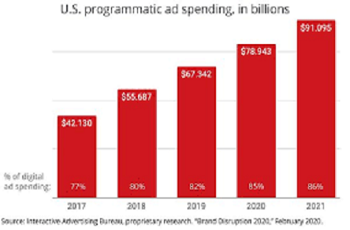According to a new report commissioned by the Interactive Advertising Bureau(IAB) and conducted by consulting firm PwC, U.S. digital ad revenue still managed to increase more than 12% in 2020 to $140 billion, despite the pandemic-fueled headwinds that resulted in marketers slashing budgets.
With the pandemic keeping audiences at home and on screens for most of the day, the industry benefited from a surge in the number of digitally-connected consumers during lockdowns, according to the report.
Year-over-year growth declined by 5.2% in the second quarter, the IAB report said, but spending during the third and fourth quarters was up by 11.7% and 28.7% year-over-year, respectively. The report said the fourth quarter of 2020 saw the highest revenue on record for digital advertising in more than 20 years, which it attributed in part to advertising leading up to the election. Advertisers were also spending 2020 budgets that had been paused earlier in the year because of the pandemic.
“The second half of 2020 made up for the rather abrupt drop in advertising revenue experienced toward the end of the second quarter,” Susan Hogan, senior VP, research and analytics, IAB, said in a statement. “We not only had a rebound, we also had double-digit growth. The Q4 holiday season sales, typical use-it-or-lose-it year-end spending of media budgets, and revenue from political advertising all helped to offset the early COVID-19-induced decline.”
The surges in consumer adoption of connect TV, e-commerce shopping and at-home deliveries created the need for digital media to continue growing, she added.
In fact, the fourth quarter of the year saw the highest revenue on record for digital advertising in more than 20 years, which was buoyed in part by advertising leading up to the election.
Digital video grew by 20.6% to $26.2 billion, while social media ad revenues reached $41.5 billion, up 16.3%. Programmatic ad revenues increased 24.9% year-over-year to $14.2 billion, but it remains to be seen how the end of third-party cookies and other privacy changes will impact this figure moving forward.
“The deprecation of third party cookies and identifiers leave many to wonder if this level of growth is sustainable,” Hogan said. “There is some concern that programmatic delivery could be negatively impacted once third party tracking is blocked.”







Comment
No comments found.